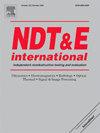基于矩阵阵的复杂几何构件自适应超声检测技术
IF 4.5
2区 材料科学
Q1 MATERIALS SCIENCE, CHARACTERIZATION & TESTING
引用次数: 0
摘要
超声相控阵技术广泛应用于许多无损检测领域。其电子引导和聚焦超声波光束的能力可以提高精度进行全面检查。然而,当被检查的部件表面不均匀时,超声波检查的性能可能会降低。如果表面几何形状未知,相控阵技术无法使用阵列设置来纠正声波束的扰动。在这项工作中,我们提出了一种新的浸入式自适应检测技术,该技术使用矩阵阵列对大型和复杂形状的部件进行检测。在这种方法中,首先,利用矩阵阵列的一行和一列作为两个独立的正交一维阵列,结合机械二维扫描,从收集的一系列二维TFM图像中重建被检测部件的未知表面几何形状。在这一阶段,通过旋转SAFT算法(标准SAFT方法的简化版本)将记录的2D图像合并为单个宽视图3D表面图像。使用自动全局阈值法从生成的图像中提取所需的表面。然后,在给定检测探头轨迹的基础上,根据重构曲面计算出检测部件内部的自适应焦点律,并在探头的每个位置应用自适应焦点律来修正曲面的影响。在水箱中进行的各种模拟和实验结果说明了所提出的检测技术的能力。本文将讨论其优点和缺点。本文章由计算机程序翻译,如有差异,请以英文原文为准。
Adaptive ultrasonic technique for inspection of complex geometry components with a matrix array
Ultrasonic phased-array technology is widely used in many NDT (Non-Destructive Testing) fields. Its ability to electronically steer and focus ultrasonic beams allows for comprehensive inspections with improved accuracy. However, the performances of an ultrasonic inspection may be degraded when the component being inspected exhibits an uneven surface. If the surface geometry is unknown, phased array technology is unable to correct the perturbations of acoustical beams using array settings. In this work, we present a new immersion adaptive inspection technique of large and complex-shaped components using a matrix array. In this approach, first, the unknown surface geometry of the inspected component is reconstructed from a series of 2D TFM images collected using only one row and one column of the matrix array acting as two independent orthogonal 1D arrays, in conjunction with mechanical 2D scanning. At this stage, the recorded 2D images are combined into a single wide-view 3D surface image by rotational SAFT algorithm, a simplified version of the standard SAFT method. The desired surface is extracted from the resulting image using an automatic global thresholding method. Then, based on the reconstructed surface and given the inspection probe trajectory, adapted focal laws to inspect the interior of the component are computed and applied at every location of the probe to correct the effect of the surface. The capabilities of the proposed inspection technique are illustrated by various simulated and experimental results carried out in a water tank. Its advantages and drawbacks will be discussed.
求助全文
通过发布文献求助,成功后即可免费获取论文全文。
去求助
来源期刊

Ndt & E International
工程技术-材料科学:表征与测试
CiteScore
7.20
自引率
9.50%
发文量
121
审稿时长
55 days
期刊介绍:
NDT&E international publishes peer-reviewed results of original research and development in all categories of the fields of nondestructive testing and evaluation including ultrasonics, electromagnetics, radiography, optical and thermal methods. In addition to traditional NDE topics, the emerging technology area of inspection of civil structures and materials is also emphasized. The journal publishes original papers on research and development of new inspection techniques and methods, as well as on novel and innovative applications of established methods. Papers on NDE sensors and their applications both for inspection and process control, as well as papers describing novel NDE systems for structural health monitoring and their performance in industrial settings are also considered. Other regular features include international news, new equipment and a calendar of forthcoming worldwide meetings. This journal is listed in Current Contents.
 求助内容:
求助内容: 应助结果提醒方式:
应助结果提醒方式:


